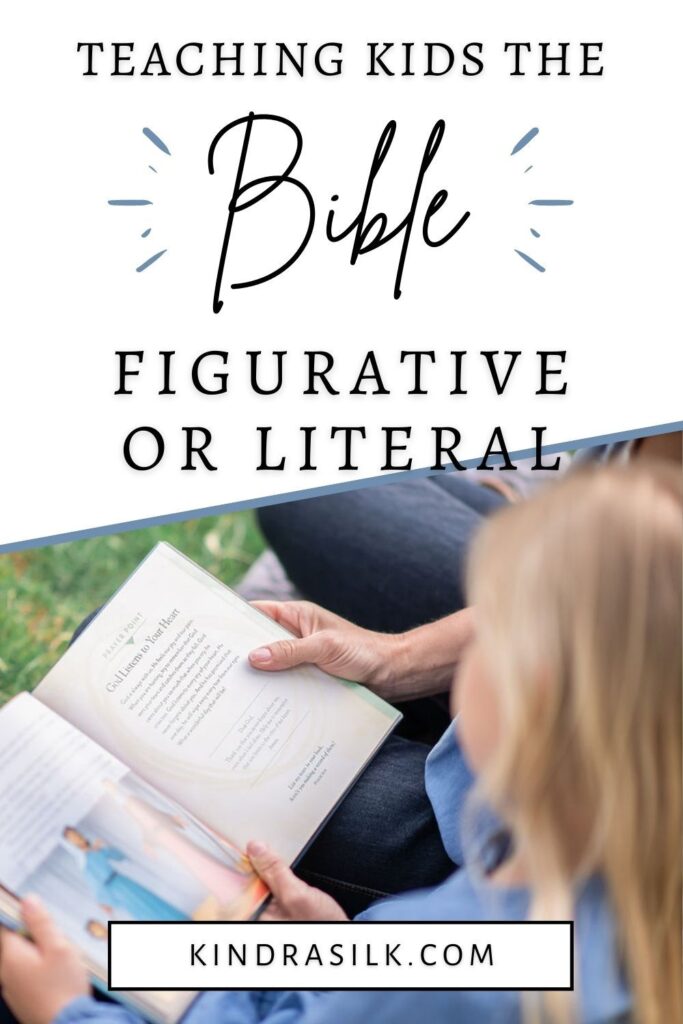It’s hard enough for us adults to decipher the difference between literal and figurative language in the Bible. Teaching kids can get even trickier.
But it doesn’t have to be.
Deciphering the difference between literal and figurative language is almost second nature in our modern speech—even for children.
Literal or Figurative Language Today
I draw the shades. My daughter nestles down in her bed.
She reads to me.
“Dot wore her yellow dress all the time.” She pauses quizzically. Then her eyes widen. “All the time? Did she wear it every day?”
I smile. She continues.
“Did her mom ever wash it? Did she sleep in it?!”
For young children, concrete literal thinking is the only way. It’s in the next stage of development they begin to expand their understanding of figurative language.
My chuckle turns sly. This is a teachable moment, if ever there was one.
“Maybe.” I raise one eyebrow. “But when we say ‘all the time’ when we usually mean ‘a lot’. We don’t really mean ‘all the time.’
She seems satisfied.
“Dot wore her dress to Grandma’s.”
She continues.
“Dot wore her dress to school. Dot wore her dress every Sunday at church.”
“Hmmm.” I try to sound like a big mystery is unfolding, and we get the adventure of solving it. “Does it sound so far like she sleeps in it?”
“No.” She keeps reading. “Mom washed Dot’s dress all the time.”
“Wait!” I interrupt. “Can Dot wear her dress all the time if mom is washing it all the time?”
“No,” she laughs.
She took the bait. Now I reel her in.

“So, if the text didn’t tell us these details, would we think she wore the yellow dress to bed every night? That she never took it off?”
“No,” she admits.
“And when someone says the ‘arm of the chair,’ do we expect it to have a real arm on it?” I shake my arm wildly.
“No.” She grins.
“Reading the Bible is like that, too.” We must think critically about what the authors mean.
Growing into Figurative Language
It takes a little time for children to move past concrete thinking and into more figurative. But around the 3rd-5th grades, most teachers will introduce and dissect figurative language types. Simile, metaphor, hyperbole, personification, and allusion are some common types they’ll look at.
Although my daughter’s not dissecting figurative language types yet, she’s gobbling up the basic concept of literal language versus all the rest. “Road apples” are particularly funny right now.
My daughter and I continue our discussion. We talk about how to understand scripture. How even 2,000 years ago people talked in ways that weren’t always literal—just like us.
We need to be able to decipher the difference. Or at least know when to pause and investigate.

Tackling Scripture with Other Christians
Even as a seminary grad, this catches me up sometimes—especially if I’m reading fresh from a new translation. And because I’m not always a literal reader, I consult my literal-leaning friends when I’m unsure. We have fantastic discussions. They are usually certain they’ve nailed down all the answers. Sometimes they persuade me. Other times, I attempt to remove a few nails on doors they’ve maybe closed too soon.
In the end, we’re each coming to scripture with desire to understand. And the desire to grow rightly under God. Neither of us wants to get it wrong. This is the heart of a Christian. In this, we are brothers and sisters in Christ.
This is also why I like to visit different churches within different denominations. I pocket fresh perspectives- and leave others where I found them. But I grow my understanding.
When my daughter witnesses iron sharpening iron, she learns to tackle scripture—and keep unity with people who understand it differently. Don’t get me wrong—there are dividing lines. But that’s a post for a different day.
The conversation about Dot’s dress arms my daughter with knowledge and practice on how to think. The conversation also keeps her up past her bedtime. But when the fruit is ripe you pick it, lest it rots tomorrow.
A Figurative vs. Literal Printable for Your Budding Theologian

Mama, we’ve created two free printables for your (aged 7-12) budding theologians. One helps little ones think critically about the figurative language around them. The other looks at older figurative language—straight from the Bible.
Sign up to download today!

P.S. If you liked this post, check out our article on teaching children the hard scriptures.


